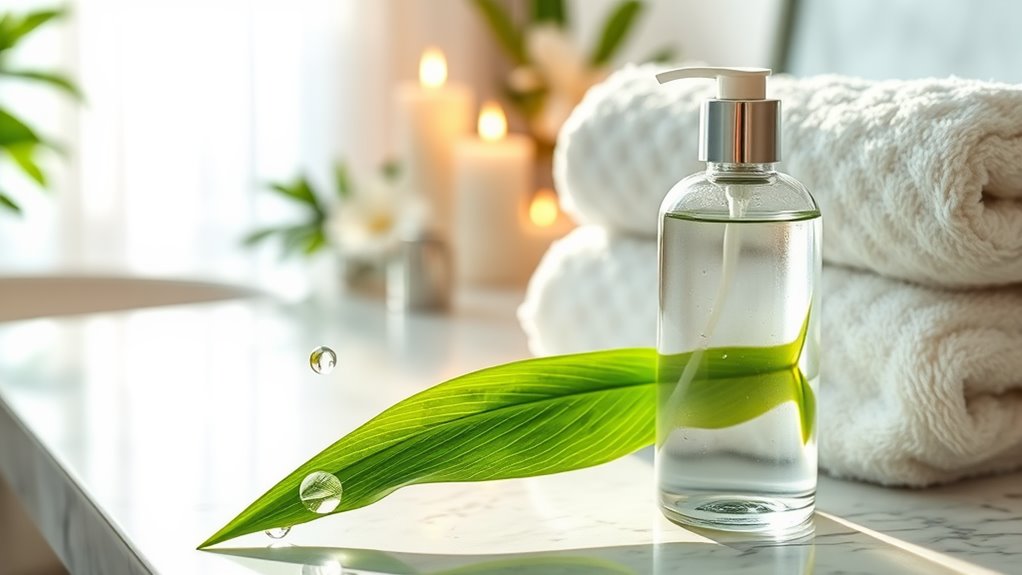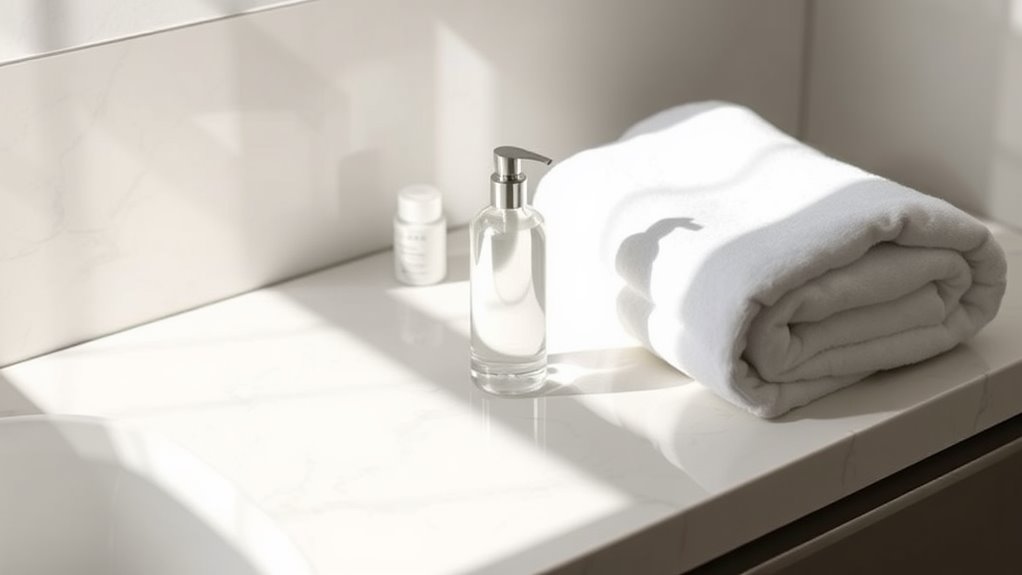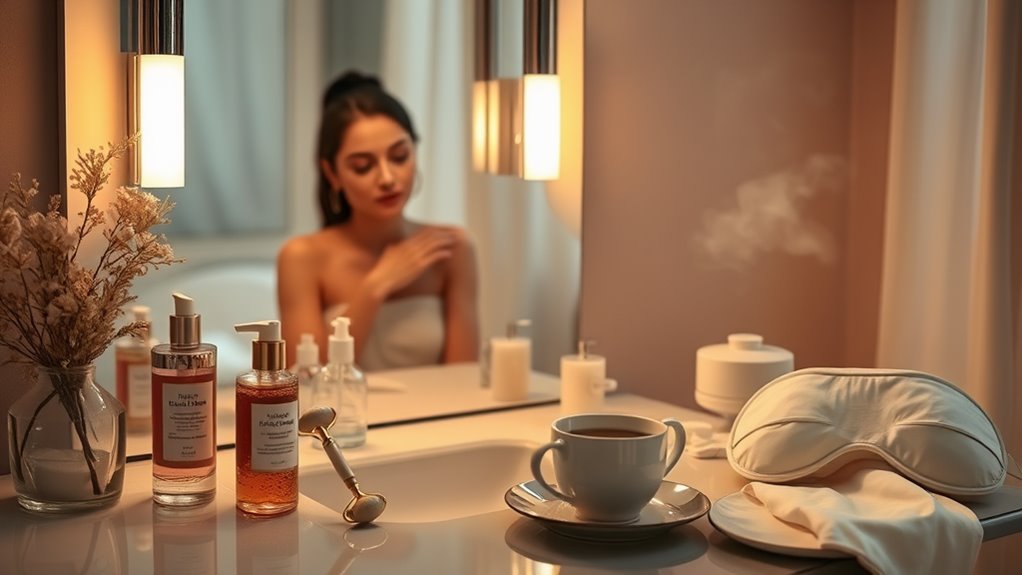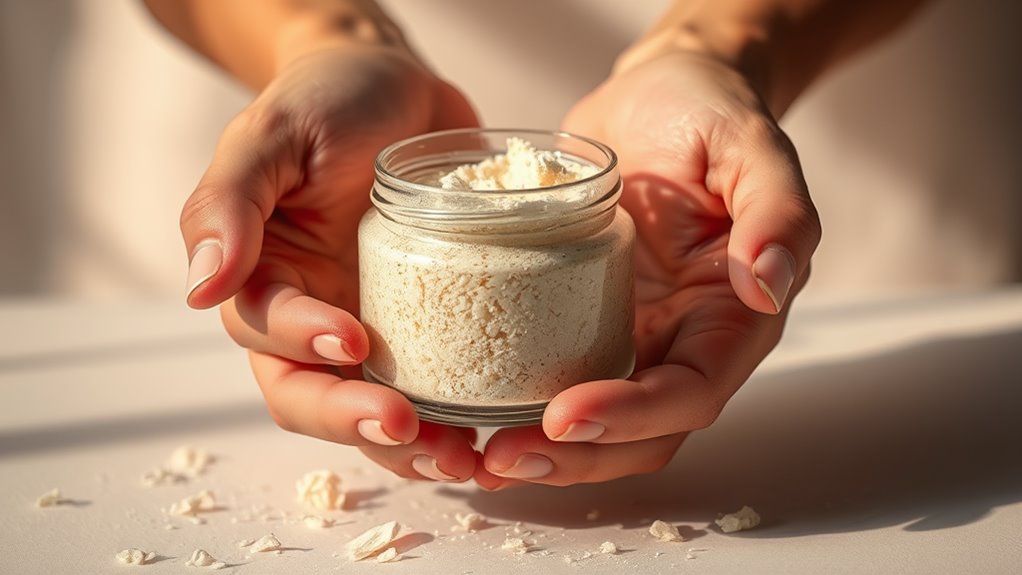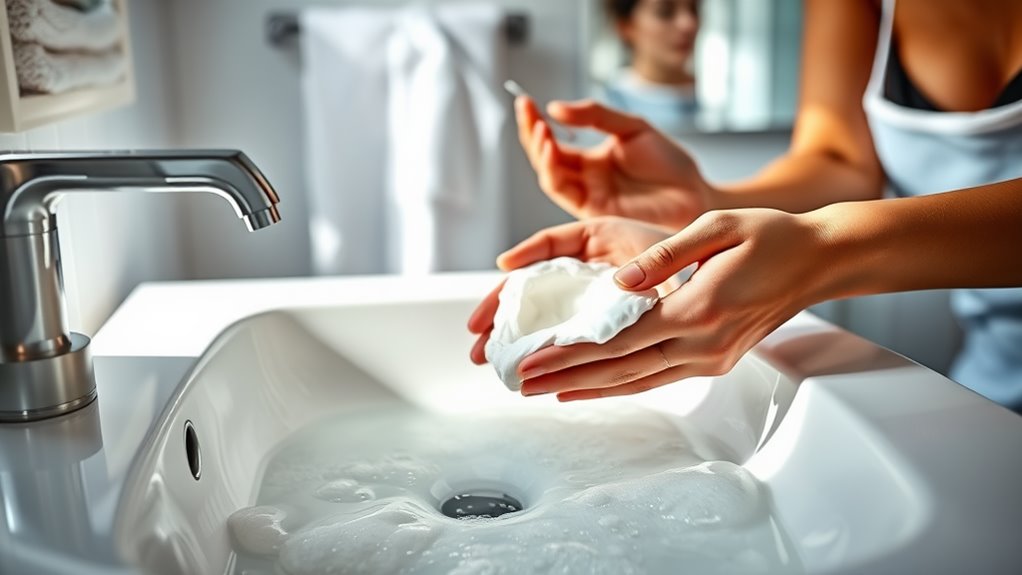Why You Should Rethink Your Cleansing Routine Today
You should rethink your cleansing routine today because many common methods overlook your unique skin type and disrupt your skin’s natural pH balance. Harsh cleansers strip essential oils, leading to irritation and breakouts, while improper makeup removal can leave residues. By adopting practices like double cleansing and customizing products for your skin’s needs, you can enhance clarity and health. There’s more to explore about optimizing your routine for clearer, healthier skin.
Key Takeaways
- Your skin type dictates the need for specific cleansers; using the wrong product can worsen skin issues.
- Double cleansing effectively removes makeup and impurities, enhancing overall skin clarity and health.
- Harsh cleansers disrupt your skin’s natural pH, leading to irritation and breakouts; gentle formulations are essential.
- Regular exfoliation improves texture and promotes cell turnover, but frequency must match your skin type for optimal results.
- Listening to your skin’s needs, such as dryness or oiliness, helps tailor your routine, ensuring better hydration and health.
Understanding Your Skin Type
How well do you really know your skin type? Identifying your skin type is crucial for effective cleansing routine advice. Your skin can fall into categories like oily, dry, combination, or sensitive, each requiring tailored care.
For instance, if you have oily skin, you’ll benefit from a foaming cleanser that removes excess sebum without stripping essential moisture. On the other hand, those with dry skin should opt for cream-based cleansers that hydrate while cleansing.
Understanding your skin type not only enhances your cleansing routine but also prevents adverse reactions. By choosing the right products, you optimize your skin’s health, leading to a clearer, more radiant complexion. The right cleanser for your skin type can make a significant difference in achieving optimal results.
Master this knowledge to elevate your skincare regimen and achieve desired results.
Common Cleansing Mistakes
Many people unknowingly make common cleansing mistakes that can undermine their skincare efforts. One prevalent error is using harsh cleansers that strip natural oils, leading to irritation and rebound oil production.
Additionally, many skip the double cleansing method, which is crucial for thoroughly removing makeup and impurities. Over-cleansing is another frequent mistake; doing so can disrupt your skin’s barrier and result in dryness.
You might also overlook the importance of cleansing for the right duration—rushing through can leave residues behind. Finally, neglecting to tailor your cleansing routine to your specific skin type can exacerbate existing issues. Moreover, using harsh cleansers can particularly damage your skin barrier, making it essential to choose gentler options.
The Role of Ph Balance in Cleansing
When it comes to cleansing, pH balance plays a crucial role in maintaining skin health. Your skin’s natural pH is slightly acidic, typically around 4.5 to 5.5.
Using products that disrupt this balance can lead to irritation and breakouts. To optimize your routine, consider these key factors:
-
Gentle Formulations: Choose cleansers that respect your skin’s pH.
-
Hydration Boost: Look for ingredients like glycerin that help retain moisture.
-
Avoid Harsh Agents: Steer clear of sulfates and heavy detergents that can strip your skin.
-
Regular Monitoring: Test your skin’s pH occasionally to ensure it remains within a healthy range. Additionally, harsh cleansers can alter the skin’s natural barrier, making it more susceptible to damage.
Importance of Double Cleansing
Maintaining the right pH balance is just one aspect of an effective cleansing routine; incorporating double cleansing can significantly enhance your skin’s health and appearance. This method involves two steps: using an oil-based cleanser to dissolve makeup and sebum, followed by a water-based cleanser to remove residual impurities. Studies suggest that this technique improves skin clarity and reduces breakouts. Additionally, revamping your cleansing routine can lead to healthier skin by addressing common misconceptions about cleansing practices.
| Step | Purpose | Benefits |
|---|---|---|
| Oil-based cleanser | Dissolves makeup & sebum | Prepares skin for deeper clean |
| Water-based cleanser | Removes residual impurities | Balances and hydrates skin |
| Frequency | Daily or as needed | Optimal skin health |
| Skin types | All skin types | Tailored approach |
| Final result | Clearer, healthier skin | Enhanced radiance |
Choosing the Right Cleansing Products
How do you know which cleansing products are right for your skin? Selecting the right products can significantly enhance your cleansing routine.
First, assess your skin type: oily, dry, combination, or sensitive. Next, consider ingredients that cater to your specific needs.
Here’s a guide to help you choose:
-
Gel Cleansers: Ideal for oily skin, these remove excess sebum without over-drying.
-
Cream Cleansers: Perfect for dry skin, they hydrate while cleansing.
-
Foam Cleansers: Great for combination skin, offering a balanced cleanse.
-
Micellar Water: Suitable for sensitive skin, it gently removes impurities without irritation. Additionally, opting for gentle cleansing products can help maintain hydration and prevent the common issue of over-drying your skin.
When to Cleanse: Morning vs. Evening
Cleansing your skin at the right times is crucial for maintaining its health and balance.
In the morning, a gentle cleanse prepares your skin for the day, removing overnight oil buildup and sweat. This allows your skincare products to penetrate effectively and ensures a fresh canvas for makeup application.
In the evening, cleansing serves a different purpose. It removes dirt, pollutants, and makeup, preventing clogged pores and breakouts. Choosing the right time to cleanse not only enhances your skin’s appearance but also supports its natural reparative processes during sleep.
Ultimately, a consistent routine that incorporates both morning and evening cleansing optimizes skin health, promoting clarity and resilience.
Prioritize these moments for the best results.
The Impact of Environmental Factors
Environmental factors like pollution and seasonal changes can significantly affect your skin’s health.
When you understand how these elements impact your complexion, you can tailor your cleansing routine accordingly.
It’s essential to adapt your products and techniques to combat these external influences effectively.
Pollution and Skin Health
As you navigate your daily routine, it’s crucial to recognize that pollution significantly impacts your skin health. Environmental pollutants can lead to premature aging, breakouts, and dullness.
To effectively combat these effects, consider incorporating the following into your cleansing routine:
-
Antioxidant-rich cleansers: These help neutralize free radicals caused by pollution.
-
Exfoliating agents: Regular exfoliation removes dead skin cells and pollutants, promoting a brighter complexion.
-
Hydrating ingredients: Products containing hyaluronic acid can replenish moisture lost due to environmental stressors.
-
SPF protection: Daily sunscreen acts as a barrier against UV damage and pollutants, preserving your skin’s integrity.
Seasonal Changes Effects
When the seasons change, your skin often reacts to varying temperatures, humidity levels, and sunlight exposure.
These environmental factors can significantly influence your skin’s hydration, barrier function, and overall health. For instance, colder months may lead to dryness and flakiness, while summer heat can increase oil production and exacerbate acne.
Elevated UV exposure in warmer seasons necessitates effective cleansing to remove sweat and sunscreen residues that could clog pores. Adjusting your cleansing routine seasonally not only addresses these changes but also optimizes your skin’s resilience.
Consider incorporating hydrating ingredients in winter and lightweight formulas in summer. By tailoring your approach, you enhance your skin’s ability to adapt, ensuring it remains balanced and radiant throughout the year.
Addressing Makeup Removal Myths
How effective is your makeup removal routine? Many believe that a simple wipe or splash of water suffices. However, misconceptions can lead to skin issues.
Let’s debunk some common myths:
-
Facial Wipes Are Enough: They often leave residue and don’t cleanse deeply.
-
Cleansing Oils Aren’t Necessary: They effectively dissolve stubborn makeup and unclog pores.
-
One Step Is Sufficient: Double cleansing ensures complete removal of dirt and makeup.
-
Suds Equal Clean: The absence of lather doesn’t mean a product isn’t effective; many gentle cleansers work without foam.
Understanding these myths can transform your routine, ensuring your skin remains healthy and radiant.
Prioritize effective makeup removal for optimal skin health.
Incorporating Exfoliation Into Your Routine
Incorporating exfoliation into your skincare routine can significantly enhance your skin’s texture and appearance.
Understanding the different types of exfoliants, from physical to chemical, helps you choose the right one for your needs.
Additionally, knowing how often to exfoliate is crucial for achieving optimal results without causing irritation.
Benefits of Exfoliation
Exfoliation is a vital step in any effective skincare routine, offering a range of benefits that enhance your complexion and overall skin health.
By incorporating exfoliation, you can experience:
-
Improved Skin Texture: Smooth away rough patches, revealing softer, more radiant skin.
-
Enhanced Absorption: Allow your serums and moisturizers to penetrate deeper, maximizing their efficacy.
-
Diminished Pores: Unclog pores, reducing their appearance and minimizing breakouts.
-
Even Skin Tone: Fade dark spots and hyperpigmentation, promoting a more uniform complexion.
Regular exfoliation not only revitalizes your skin but also encourages cell turnover, maintaining its youthful glow.
Embrace these benefits and elevate your skincare routine for lasting results.
Types of Exfoliants
Choosing the right type of exfoliant can significantly impact your skincare routine, as each option offers unique benefits tailored to different skin needs. Here are the main types to consider:
| Exfoliant Type | Benefits |
|---|---|
| Physical | Provides immediate results; manually sloughs off dead skin. |
| Chemical | Penetrates pores; promotes cell turnover with acids. |
| Enzymatic | Gentle alternative; uses natural enzymes to dissolve dead skin. |
| Microdermabrasion | Professional treatment; deeply exfoliates for a polished look. |
Frequency Recommendations
How often should you exfoliate to achieve optimal results without damaging your skin? The frequency largely depends on your skin type and the exfoliant used. Here are some guidelines to consider:
-
Oily or acne-prone skin: Exfoliate 2-3 times per week to unclog pores and reduce excess sebum.
-
Dry or sensitive skin: Limit exfoliation to once a week to avoid irritation and maintain moisture.
-
Normal skin: Exfoliate 1-2 times per week to enhance texture and radiance.
-
Combination skin: Tailor your routine based on the specific areas—exfoliate 1-3 times weekly as needed.
Listening to Your Skin’s Needs
What if tuning into your skin’s unique signals could transform your cleansing routine? Your skin communicates its needs through texture, oiliness, and sensitivity. By observing these cues, you can tailor your cleansing approach for optimal results.
For instance, if your skin feels tight or dry after cleansing, it may indicate that you’re using a product too harsh for your skin type. Conversely, excess oil production might suggest a need for a more effective cleanser.
Incorporate gentle exfoliation if your skin appears dull, but don’t overdo it. Remember, hydration is key; listen for signs of dehydration.
